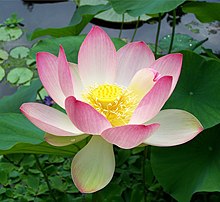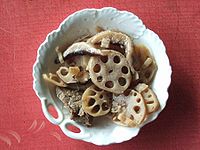Nelumbo nucifera
From Wikipedia, the free encyclopedia
"Lotus Flower" redirects here. For the Woody Shaw album, see Lotus Flower (Woody Shaw album). For the Radiohead song, see Lotus Flower (song). For the religious symbol, see Padma (attribute).
| Nelumbo nucifera | |
|---|---|
 | |
| Scientific classification | |
| Kingdom: | Plantae |
| (unranked): | Angiosperms |
| (unranked): | Eudicots |
| Order: | Proteales |
| Family: | Nelumbonaceae |
| Genus: | Nelumbo |
| Species: | N. nucifera |
| Binomial name | |
| Nelumbo nucifera Gaertn. | |
| Synonyms | |
| |
Nelumbo nucifera, also known as Indian lotus, sacred lotus, bean of India, or simply lotus, is one of two species of aquatic plant in the familyNelumbonaceae. The Linnaean binomial Nelumbo nucifera (Gaertn.) is the currently recognized name for this species, which has been classified under theformer names, Nelumbium speciosum (Willd.) andNymphaea nelumbo, among others. (These names are obsolete synonyms and should be avoided in current works.) This plant is an aquatic perennial. Under favorable circumstances its seeds may remain viable for many years, with the oldest recorded lotus germination being from that of seeds 1,300 years old recovered from a dry lakebed in northeastern China.[1]
Native to Tropical Asia and Queensland,Australia,[2][3] it is commonly cultivated in water gardens. It is also the national flower of India andVietnam.
Contents
[hide]Classification[edit]
See also: Nelumbo
While all modern plant taxonomy systems agree that this species belongs in the genus Nelumbo, the systems disagree as to which family Nelumbo should be placed in, or whether the genus should belong in its own unique family and order.
The lotus is often confused with the water lilies (Nymphaea, in particularNymphaea caerulea, sometimes called the "blue lotus"). In fact, several older systems, such as Bentham and Hooker (which is widely used in the Indian subcontinent) call the lotus Nymphaea nelumbo or Nymphaea stellata. This is, however, evolutionarily incorrect, as the lotus and water-lilies are practically unrelated. Far from being in the same family, Nymphaea and Nelumbo are members of different orders (Nymphaeales and Proteales respectively).
Botany[edit]
The roots of lotus are planted in the soil of the pond or river bottom, while the leaves float on top of the water surface or are held well above it. The flowers are usually found on thick stems rising several centimeters above the leaves. The plant normally grows up to a height of about 150 cm and a horizontal spread of up to 3 meters, but some unverified reports place the height as high as over 5 meters. The leaves may be as large as 60 cm in diameter, while the showy flowers can be up to 20 cm in diameter.
Researchers report that the lotus has the remarkable ability to regulate thetemperature of its flowers to within a narrow range just as humans and otherwarmblooded animals do.[4] Dr. Roger S. Seymour and Dr. Paul Schultze-Motel, physiologists at the University of Adelaide in Australia, found that lotus flowers blooming in the Adelaide Botanic Gardens maintained a temperature of 30–35 °C (86–95 °F), even when the air temperature dropped to 10 °C (50 °F). They suspect the flowers may be doing this to attractcoldblooded insect pollinators. The study, published in the journal Nature, is the latest discovery in the field of thermoregulation, heat-producing, plants. Two other species known to be able to regulate their temperature includeSymplocarpus foetidus and Philodendron selloum.
An individual lotus can live for over a thousand years and has the rare ability to revive into activity after stasis. In 1994, a seed from a sacred lotus, dated at roughly 1,300 years old ± 270 years, was successfully germinated.[5][6]
As mentioned earlier, the traditional Sacred Lotus is only distantly related toNymphaea caerulea, but possesses similar chemistry. Both Nymphaea caerulea and Nelumbo nucifera contain the alkaloids nuciferine andaporphine.
Uses[edit]
| Nutritional value per 100 g (3.5 oz) | |
|---|---|
| Energy | 278 kJ (66 kcal) |
16.02 g | |
| Sugars | 0.50 g |
| Dietary fiber | 3.1 g |
0.07 g | |
1.58 g | |
| Vitamins | |
| Thiamine (B1) | (11%) 0.127 mg |
| Riboflavin (B2) | (1%) 0.01 mg |
| Niacin (B3) | (2%) 0.3 mg |
(6%) 0.302 mg | |
| Vitamin B6 | (17%) 0.218 mg |
| Folate (B9) | (2%) 8 μg |
| Choline | (5%) 25.4 mg |
| Vitamin C | (33%) 27.4 mg |
| Trace minerals | |
| Calcium | (3%) 26 mg |
| Iron | (7%) 0.9 mg |
| Magnesium | (6%) 22 mg |
| Manganese | (10%) 0.22 mg |
| Phosphorus | (11%) 78 mg |
| Potassium | (8%) 363 mg |
| Sodium | (3%) 45 mg |
| Zinc | (3%) 0.33 mg |
| Other constituents | |
| Water | 81.42 g |
| |
| Percentages are roughly approximated usingUS recommendations for adults. Source: USDA Nutrient Database | |
The distinctive dried seed heads, which resemble the spouts of watering cans, are widely sold throughout the world for decorative purposes and for dried flower arranging.
The flowers, seeds, young leaves, and "roots" (rhizomes) are all edible. In Asia, the petals are sometimes used for garnish, while the large leaves are used as a wrap for food, not frequently eaten (for example, as a wrapper forzongzi). In Korea, the leaves and petals are used as a tisane. Yeonkkotcha (연꽃차) is made with dried petals of white lotus and yeonipcha (연잎차) is made with the leaves. Young lotus stems are used as a salad ingredient in Vietnamese cuisine. The rhizome (called ǒu (藕) in pinyinChinese, ngau in Cantonese, thambou inManipuri, kamal kakri in Hindi, renkon (レンコン,蓮根) in Japanese, and yeongeun (연근) inKorean) is used as a vegetable in soups, deep-fried, stir-fried, and braised dishes and the roots are also used in traditional Asian herbal medicine. Petals, leaves, andrhizome can also all be eaten raw, but there is a risk of parasite transmission (e.g., Fasciolopsis buski): it is therefore recommended that they be cooked before eating.
Lotus rootlets are often pickled with rice vinegar, sugar, chili and/or garlic. It has a crunchy texture with sweet-tangy flavours. In Asian cuisine, it is popular with salad, prawns, sesame oil and/or coriander leaves. Lotus roots have been found to be rich in dietary fiber, vitamin C, potassium, thiamin,riboflavin, vitamin B6, phosphorus, copper, and manganese, while very low insaturated fat.[citation needed]
The stamens can be dried and made into a fragrant herbal tea called liánhuā cha (蓮花茶) in Chinese, or (particularly in Vietnam) used to impart a scent totea leaves. This Vietnamese lotus tea is called trà sen, chè sen, or chè ướp sen. The lotus seeds or nuts (called liánzĭ, 蓮子; or xiān liánzĭ, 鲜莲子, in Chinese) are quite versatile, and can be eaten raw or dried and popped likepopcorn, phool makhana. They can also be boiled until soft and made into a paste, or boiled with dried longans and rock sugar to make a tong sui (sweet soup). Combined with sugar, lotus seed paste becomes one of the most common ingredients used in pastries such as mooncakes, daifuku, and riceflour pudding.[10]
In South Indian states, the lotus stem is sliced, marinated with salt to dry, and the dried slices are fried and used as a side dish. In Kerala and Tamil Nadu, this end product is called " Thamara Vathal". In Sri Lanka, finely sliced lotus rhizome cooked with coconut milk and spices is a popular curry known as Nelum Ala (නෙලුම් අල). In Vietnam, the bitter tasting germs of the lotus seeds are also made into a tisane (trà tim sen).
A unique fabric from the lotus plant fibers is produced only at Inle lake,Union of Myanmar and is used for weaving special robes for Buddha images called kya thingahn (lotus robe).
Cultural significance[edit]
Main article: Padma (attribute)
Nelumbo nucifera is the species of lotus sacred to both Hindus and Buddhists.[11]
Hindus revere it with the divinities Vishnu and Lakshmioften portrayed on a pink lotus in iconography. In the representation of Vishnu as Padmanabha (Lotus navel), a lotus issues from his navel with Brahma on it. GoddessSarasvati is portrayed on a white-colored lotus.
Often used as an example of divine beauty, Vishnu is often described as the 'Lotus-Eyed One'. Its unfolding petals suggest the expansion of the soul. The growth of its pure beauty from the mud of its origin holds a benign spiritual promise. In Hindu iconography, other deities, like Ganga and Ganesha are often depicted with lotus flowers as their seats.
Most deities of Asian religions are depicted as seated on a lotus flower. InBuddhist symbolism, the lotus represents purity of the body, speech, and mind as if floating above the muddy waters of attachment and desire. According to legend[citation needed], Gautama Buddha was born with the ability to walk, and lotus flowers bloomed everywhere he stepped. In Christianity, the St. Thomas Cross features a lotus underneath a cross.
In the classical written and oral literature of many Asian cultures the lotus is present in figurative form, representing elegance, beauty, perfection, purity and grace, being often used in poems and songs as an allegory for ideal feminine attributes. In Sanskrit the word lotus (padma पद्म) has manysynonyms. Since the lotus thrives in water, ja (denoting birth) is added to synonyms of water to derive some synonyms for the lotus, like ambuja(ambu= water + ja=born of), neeraj (neera=water + ja= born of), pankaj,pankaja, kamal, kamala, kunala, aravind, arvind, nalin,nalini and saroja[13] and names derived from the lotus, like padmavati (possessing lotuses) or padmini(full of lotuses).[14] These names and derived versions are often used to name girls, and to a lesser extent boys, in India, Nepal and Sri Lanka, as well as in many other countries influenced by Indic culture, like Thailand,Cambodia, Indonesia and Laos.
Drawing in turn on these beliefs, the international Bahá'í community adopted this symbolism in the design of the Lotus Temple in New Delhi, India.
Chemical composition[edit]
The flavonol miquelianin (Quercetin 3-O-glucuronide), as well as the alkaloids (+)-1(R)-coclaurine and (−)-1(S)-norcoclaurine, can be found in the leaves of N. nucifera.[15] The plant also contains nuciferine and aporphine







No comments:
Post a Comment